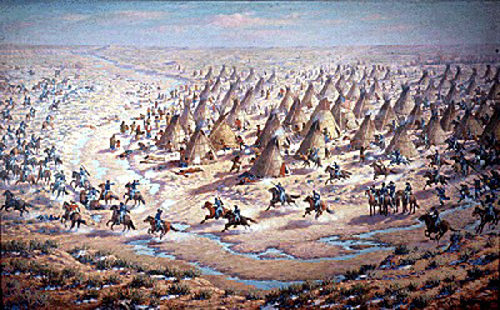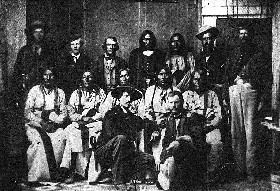The Indians soon began to attack wagon trains, mining camps and stagecoach lines, a practice that increased during the Civil War, when the number of soldiers in the area was greatly decreased. Soon, this led to what became known as the Colorado War of 1864-1865. As the violence between the Native Americans and the miners continued to increase, territorial governor John Evans sent a Voluntary Militia commander by the name of Colonel John Chivington to quiet the Indians. Chivington, though once a member of the clergy, his compassion did not extend to the Indians and his desires to extinguish them all was well known. Soon, Evans and Chivington reinforced their militia, raising the Third Colorado Cavalry of short-term volunteers who referred to themselves as the "Hundred Dazers." After a summer of scattered small raids and clashes, the Cheyennes and Arapahos were ready for peace, and as a result, the Indian representatives met with Evans and Chivington at Camp Weld outside of Denver on September 28, 1864. Though no treaties were signed, the Indiansbelieved that by reporting and camping near army posts, they would be declaring peace and accepting sanctuary. However on the day of the "peace talks” Chivington received a telegram from General Samuel Curtis (his superior officer) informing him that "I want no peace till the Indians suffer more...No peace must be made without my directions." Unaware of Curtis's telegram, Black Kettle and some 550 Cheyennes and Arapahos, having made their peace, traveled south to set up camp on Sand Creek under the promised protection of Fort Lyon. Those who remained opposed to the agreement headed North to join the Sioux. Knowing that the Indians had surrendered, Chivington led his 700 troops, many of them drinking heavily, to Sand Creek and positioned them, along with their four howitzers, around the Indian village. The ever trusting Black Kettle raised both an American and a white flag of peace over his tepee.
However, Chivington ignored the symbol of peace and surrender, raising his arm for attack. An easy victory at hand, cannons and rifles began to pound upon the camp as the Indians scattered in panic. The frenzied soldiers began to charge, hunting down men, women, and children, shooting them unmercifully. A few warriors managed to fight back allowing some members of the camp to escape across the stream. One man, Silas Soule, a Massachusetts abolitionist, refused to follow Colonel Chivington's orders. He did not allow his cavalry company to fire into the crowd. The troops kept up their indiscriminate assault for most of the day, during which numerous atrocities were committed. One lieutenant was said to have killed and scalped three women and five children who had surrendered and were screaming for mercy. Finally breaking off their attack they returned to the camp killing all the wounded they could find before mutilating and scalping the dead, including pregnant women, children and babies. They then plundered the teepees and divided up theIndians' horse herd before leaving When the attack was over, as many as 150 Indians lay dead, most of which were old men, women and children. In the meantime, the cavalry lost only 9 or ten men, with about three dozen wounded. Black Kettle and his wife followed the others up the stream bed, his wife being shot in the back and left for dead. Black Kettle's wife, although shot nine times, somehow managed to survived the attack. The survivors, over half of whom were wounded, sought refuge in the camp of the Cheyenne Dog Warriors (who had remained opposed to the peace treaty) at Smokey Hill River. Many of the Indians joined the Dog Soldiers, deciding there could be no successful negotiations with the white men and were waging war against them. Indeed, the Sand Creek Massacre is cited as a critical cause of the Little Big Horn battle, as many Cheyenne warriors simply devoted their lives to war against the US. The Colorado volunteers returned to Denver, exhibiting their scalps, to receive a hero's welcome. Initially the battle was reported in the press as a victory against a bravely-fought defense by the Cheyenne. Within weeks, however, eyewitnesses came forward offering conflicting testimony, leading to a military investigation and two Congressional investigations into the events. Silas Soule was eager to testify against Chivington. However, after he testified, Soule was murdered by Charles W. Squires, believed to have been ordered by Chivington. As the details came out, the US public was shocked by the brutality of the massacre. The congressional investigation subsequently determined the crime to be a "sedulously and carefully planed massacre." When asked at the military inquiry why children had been killed, one of the soldiers quoted Chivington as saying, "nits make lice." Though Chivington was denounced in the investigation and forced to resign, neither he nor anyone else was ever brought to justice for the massacre. While the Sand Creek Massacre outraged easterners, it seemed to please many people in Colorado Territory. Chivington later appeared on a Denver stage where he regaled delighted audiences with his war stories and displayed 100 Indian scalps, including the pubic hairs of women. As word of the massacre spread among the Indians of the southern and northern plains, their resolve to resist white encroachment stiffened. An avenging wildfire swept the land and peace returned only after a quarter of a century. Through the years, the area of the Sand Creek Massacre has continued to be visited and commemorated. An aging John Chivington returned to the area in 1887, and in 1908 Veterans of the Colorado Regiments planned a reunion at the site. In August of 1950 the Colorado Historical Society assisted local residents and the Eads and Lamar Chambers of Commerce in placing a marker atop the bluff at the Dawson South Bend. Sand Creek descendants remain active in tribal communities inMontana, Oklahoma, and Wyoming – and Council Representatives continue to work alongside the National Park Service. The massacre site was authorized as a National Historic site on August, 2, 2005. However, it will not be established until theNational Park Service acquires enough land to provide for the preservation, commemoration, and interpretation of the Sand Creek Massacre and is not yet open to the public.
Contact Information: P.O. Box 249
Eads, Colorado 81036
719-438-5916
Book your lodging right HERE online
Black Kettle (seated center) and other Cheyenne chiefs conclude successful peace talks with Major Edward W. Wynkoop (kneeling with hat) at Fort Weld, Colorado, in September 1864. Based on the promises made at this meeting, Black Kettle led his band back to the Sand Creek reservation, where they were massacred in late November. Photo courtesy National Archives.
Hope You Enjoyed The Story ! |








No comments:
Post a Comment